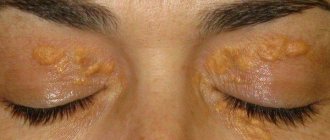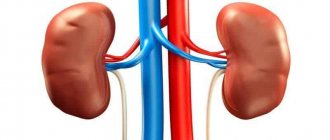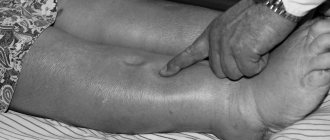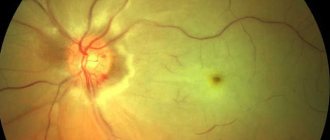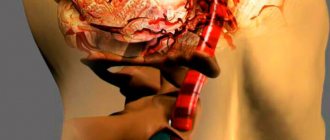General information
Neutropenia or agranulocytosis is a condition characterized by a decrease in the number of neutrophil granulocytes in the blood. With severe neutropenia in a person, the likelihood of developing fungal and bacterial infections, as well as the severity of their course, increases. With agranulocytosis, the level of leukocytes decreases to less than 1•10 per 9/L due to a decrease in the number of granulocytes (less than 0.75•10 per 9/L) and monocytes .
There are several forms of the disease depending on the pathogenesis. Speaking about neutropenia - what it is, it should be noted that this condition was first described in 1922. Currently, due to the active use of cytostatic treatment and various medications, the frequency of manifestation of this syndrome has increased.
To diagnose this condition, it is necessary to determine the number of leukocytes in the blood and the leukocyte formula. However, during the diagnostic process, it is very important to find out the cause of this manifestation in order to provide adequate treatment.
Why this condition can occur, and what treatment methods are used depending on the cause of neutropenia, will be discussed in this article.
Pathogenesis
The pathogenesis of different forms of agranulocytosis is different, and for many it has not yet been studied well enough. In autoimmune forms of the disease, the death of granulocytes occurs due to the influence of autoantibodies. In hapten agranulocytosis, the mechanism of the individual reaction of the body has not been fully studied. When haptens are administered after the first occurrence of hapten agranulocytosis, this condition will recur again.
Neutrophils
Granulocytes (neutrophils) provide protection to the body from attacks by bacteria and fungal infections. With the development of neutropenia, the response to such infections is ineffective.
The limit of the lower norm of neutrophils is 1500/μl in representatives of the Caucasian race; in people of the Negroid race this figure is slightly lower - about 1200/μl. The number of these cells is unstable - depending on the influence of various factors, it can change over a short period of time.
When the number of neutrophils decreases to <500/μl, an infectious process can develop due to the influence of endogenous microflora (in the intestines, in the mouth). If the number of these cells is reduced to <200/μl, the inflammatory response may be suppressed and typical signs of such a process (leukocytes in the urine, in the area of infection, leukocytosis) may not be observed.
In acute neutropenia , especially when combined with other factors (oncological disease, etc.), the function of the immune system is significantly impaired, which can subsequently lead to fulminant fatal infections. The risk of developing infectious processes is also affected by the integrity of the skin, mucous membranes, blood supply and tissue nutrition. People with severe neutropenia most often develop the following infectious diseases: pneumonia , furunculosis , septicemia .
The presence of places where vascular catheters were placed and injections were performed additionally increases the risk of developing skin infections. The most common pathogens are Staphylococcus aureus, coagulase-negative staphylococci, but other bacteria can also provoke the pathological process. People with agranulocytosis often develop other diseases: colitis , paraproctitis , stomatitis , otitis , sinusitis , etc. Those patients who have prolonged neutropenia after chemotherapy , stem cell transplantation, high doses of corticosteroid drugs are prone to developing fungal infections.
Classification
Depending on the severity of neutropenia, the following forms of this condition are distinguished:
- mild (neutrophil count - 1000–1500/μl);
- moderate (500–1000 µl);
- severe (less than 500/μl).
Depending on the characteristics of the process, the following forms are distinguished:
- Acute – develops quickly, over several hours or days. It results from the very rapid destruction or consumption of neutrophils.
- Chronic – develops over several months or years. As a rule, it develops due to a decrease in the production of neutrophils and excessive splenic sequestration.
Depending on the origin, the following forms of neutropenia are distinguished:
- Primary – associated with an internal lack of myeloid cells in the bone marrow.
- Secondary – associated with the influence of external factors.
According to the pathogenetic factor, the following forms of this condition are distinguished:
- Myelotoxic agranulocytosis - develops due to exposure to ionizing radiation and the influence of benzene vapor. Also, myelotoxic agranulocytosis can be a consequence of the use of cytotoxic agents.
- Immune agranulocytosis is a consequence of the influence of autoantibodies and antibodies to granulocytes after taking hapten drugs. Immune agranulocytosis can be observed with systemic lupus erythematosus , etc.
- Idiopathic form - has an unknown etiology.
Depending on the characteristics of the condition, the following forms are distinguished:
- Absolute neutropenia is a decrease in the absolute number of neutrophils in the blood. Absolute neutropenia is characteristic of a number of conditions and diseases: acute and chronic viral, bacterial and fungal diseases, autoimmune diseases, acute leukemia , lymphoma , etc.
- Relative neutropenia is a decrease in the specific gravity of neutrophils in the blood against the background of a normal or increased number of these cells.
Diagnostics
The diagnosis of neutropenia is made based on the results of a complete blood test. In case of a mild form of cell decline in a child 1-2 years old, the analysis is repeated every 10-15 days to make a diagnosis of benign neutropenia. To determine concomitant pathology, you may need:
- X-ray of the lungs;
- Ultrasound of internal organs;
- blood test (markers) to detect autoimmune, parasitic, and oncological diseases.
For a congenital disease, a myelogram is prescribed to count myeloblasts, promyelocytes and other cells. In severe cases, a bone marrow puncture is performed to examine the germ cells.
Causes
Granulocytopenia can develop due to a number of reasons, which depend on the type of disease.
- Myelotoxic agranulocytosis develops against the background of suppression of the production of myelopoiesis precursor cells in the bone marrow. It can develop as a result of exposure to cytostatic drugs, ionizing radiation on the body, and also develop as a result of taking other medications ( Streptomycin , Levomycetin , Gentamicin , Colchicine , Penicillin , etc.).
- Immune agranulocytosis develops due to the formation of antibodies that attack one’s own leukocytes. The development of hapten immune agranulocytosis is associated with the use of sulfonamides, NSAIDs-derivatives of pyrazolone, drugs prescribed to patients with tuberculosis , diabetes mellitus , and helminth infections . Haptens form complex compounds with blood proteins or leukocyte membranes and become antigens to which the body begins to produce antibodies. The immune form of the disease also develops in a number of diseases - influenza , yellow fever , malaria , infectious mononucleosis , viral hepatitis, typhoid fever , polio , etc.
- Autoimmune agranulocytosis develops as a result of a pathological reaction of the immune system, as a result of which antineutrophil antibodies are formed. A similar form is observed in patients with autoimmune thyroiditis , systemic lupus erythematosus , rheumatoid arthritis , etc.
- Severe agranulocytosis can develop as a result of chronic lymphocytic leukemia , aplastic anemia , Felty's syndrome .
- The congenital form of the disease develops due to genetic disorders.
Neutropenia, associated with insufficient bone marrow production, is observed in megaloblastic anemia associated with deficiency of folic acid and vitamin B 12 .
The process of neutrophil production can be disrupted by multiple myeloma, leukemia, lymphoma, or metastatic tumors.
Febrile neutropenia (neutropenic fever) is a condition that threatens the patient’s life and develops acutely. At the same time, the number of neurophils in the blood decreases to below 500/mm3. Febrile neutropenia occurs during or after cytostatic chemotherapy for leukemia, and is less common during cytostatic chemotherapy in the treatment of other cancers. It is also possible for this condition to develop after radiation therapy, etc.
Causes of neutropenia
The causes of the disease lie in problems with bone marrow development. This disease can be divided into 2 categories: congenital and acquired. Congenital neutropenia is a very rare phenomenon. It can be caused by hereditary factors, pathology of the pancreas, HIV and kidney failure, bone marrow pathology, and oncology. The most common causes of acquired neutropenia are side effects of long-term medication (antibiotics, antimetabolites, antitumor drugs).
Symptoms of neutropenia
As a rule, symptoms of neutropenia in children and adults do not develop until the infectious process begins to progress in the body.
Most often, the main manifestation of infectious processes is fever. In this case, the typical symptoms of focal inflammation - pain, swelling, redness, infiltrates - may be absent. Sometimes focal symptoms develop in adults and children, such as mouth ulcers. But they can also be insignificant.
Signs of drug-induced neutropenia may include fever, rash, and lymphadenopathy.
In general, signs of agranulocytosis may be as follows:
- Manifestation of severe weakness.
- Joint pain.
- Pale skin.
- Heavy sweating.
- High body temperature.
- Ulcerative lesions of the pharynx and oral cavity.
Signs of myelotoxic agranulocytosis, in addition to those listed above, include moderate hemorrhagic syndrome. In this case hematomas , nosebleeds and hematuria develop. Myelotoxic agranulocytosis can lead to vomiting and stool containing blood, and bleeding gums.
Signs characteristic of immune agranulocytosis, as a rule, develop acutely. The immune type of the disease is manifested by fever , weakness , and sweating . Ulcerative-necrotic processes develop in the oral cavity. As a result of lesions of the pharynx and oral cavity, stomatitis , pharyngitis , gingivitis , tonsillitis , etc. can develop. Ulcerations with a grayish coating, necrotic plaques, and ulcers on the tonsils (the so-called agranulocytic tonsillitis) appear on the mucous membrane.
lymphadenitis may develop .
What is neutropenia?
Neutropenia is characterized by a significant decrease in neutrophils, a type of white blood cell that is an important first line of defense against infection. The main complication of neutropenia is an increased risk of infection.
Neutrophils are a type of white blood cell that plays a critical role in protecting the body from acute bacterial and some fungal infections. Neutrophils typically make up 45 to 75% of the total white blood cells in the bloodstream. Without the important protection that neutrophils provide, the body has difficulty coping with infections, so one of these infections can be fatal for a person.
Neutrophils are produced in the bone marrow. Neutrophils are short-lived cells that are widely distributed throughout the body and can penetrate tissues that other cells cannot.
Most often, neutropenia develops in cancer patients (both adults and children) due to chemotherapy. The drugs destroy neutrophils along with the cancer cells they are designed to kill.
Neutropenia may resolve rapidly as the infection resolves or exposure ceases. Chronic neutropenia in adults can last for months or years.
Tests and diagnostics
Doctors may suspect neutropenia in people who have frequent, severe infections or unusual infections. This condition is also highly likely to occur in patients undergoing radiation therapy and receiving cytotoxic drugs.
- Anamnesis must be taken into account: the doctor must know what medications or toxic substances the patient took.
- Granulocytopenia is determined by conducting a laboratory blood test to determine the leukocyte formula. A blood test can detect agranulocytosis.
- Culture may also be done to determine infection.
- However, in the diagnostic process, it is important not only to determine the presence of this phenomenon, but also to find out the mechanism and reason for its development. For this purpose, the doctor conducts a physical examination and questioning of the patient.
- A urine and stool test is performed.
- An informative method of investigation is chest radiography.
- People who are immunocompromised have a chest CT scan.
- Other tests are also ordered depending on signs of infection.
Bone marrow testing is performed to determine whether the development of neutropenia is due to decreased production of neutrophils by the bone marrow.
Treatment methods and drugs
Most often, mild forms of neutropenia occur in children, which do not require constant intervention. It is recommended to take medications that support the immune system, and special attention to the child’s personal hygiene, especially the oral cavity.
In more serious cases, treatment is selected depending on the nature of the disease and the reasons that caused the syndrome. If neutropenia occurs as a result of taking medications or against the background of another disease, then first of all the already prescribed treatment is adjusted.
The complex of further actions combines the use of antibiotics, vitamins, excipients for the gastrointestinal tract and immunostimulants. In case of chronic syndrome, a strategy of continuous maintenance therapy is usually chosen. With this type of treatment, drugs are administered periodically, preventing the acute stage.
In the most severe forms, surgery (removal of the affected organs) or a bone marrow transplant may be required. The latter procedure can only be performed on children over 12 years of age.
Treatment with folk remedies
The use of traditional methods can help improve the body's defenses, since when the number of neutrophils decreases, the body's resistance decreases. Folk remedies can be used as a complement to the main treatment, after consulting with a doctor.
- Infusion of walnut leaves . Chop young walnut leaves (30 g) and pour 300 ml of boiling water into a thermos. Leave for 12 hours, drink 50 ml of the drink once a day. It is also recommended to eat a few walnuts every day.
- Onion infusion . Mix 250 onions, pre-finely chopped, with 1 tbsp. sugar and pour a glass of water. Cook for an hour, then cool and store in the refrigerator. Consume several spoons every day.
- Herbal teas . To boost immunity, it is recommended to drink herbal tea with honey. Its composition in different variations may include chamomile, mint, strawberry and blueberry leaves, lemon balm, etc.
- Blend to boost immunity . To prepare it, mix 500 g of cranberries and apples with 200 g of sugar. Add 1 tbsp. water and bring to a boil. When the mixture has cooled slightly, add 300 g of honey. Use 1 tbsp. l. three times a day.
- Remedy for immunity with aloe . It is necessary to keep 500 g of aloe leaves from a plant at least 3 years old in the refrigerator for about 5 days. Before picking the leaves, aloe should not be watered for two weeks. Next, the leaves should be twisted into a meat grinder, add 300 g of honey and 300 ml of Cahors. Drink 1 tbsp three times a day. l. before eating.
Symptoms
If there are any signs of illness, do not risk your child’s health - consult a doctor! Choose a specialist yourself or contact our help desk. The best doctors in Moscow are ready to see you:
351 pediatricians, 9 hematologists, 1 of them takes house calls.
In the vast majority of cases, the condition is asymptomatic and is detected accidentally, as part of a routine examination, when it is impossible to accurately determine either the onset of its development or the causes.
Congenital pathologies make themselves felt already in the neonatal period. An infant may have breathing problems, pulmonary edema, and inflammatory diseases of the oral cavity (stomatitis, gingivitis). Long-term healing of wounds is noted, primarily the umbilical one. These are nonspecific symptoms that may indicate a variety of diseases and pathologies, so you should consult your doctor.
Prevention
- The essence of preventing agranulocytosis is to provide patients at risk of developing this condition with careful and regular hematological monitoring. This is necessary, first of all, during the period of use of myelotoxic drugs.
- It is important to exclude the use of those medications that have previously provoked manifestations of immune agranulocytosis .
- It is also important to practice general preventive measures: strengthen the body's defenses, practice physical activity, healthy eating.
- All infectious diseases should be treated promptly and under the supervision of a physician.
Causes of congenital neutropenia
- Kostman's syndrome
- Shwachman-Diamond syndrome
- Fanconi anemia
- Inborn errors of metabolism (including glycogen storage disease 1b and methylmalonic aciduria syndrome)
- Immunodeficiency (including hyperimmune IgM syndrome, X-linked agammaglobulinemia, hypogammaglobulinemia)
- Myelocathexis
- Reticular dysgenesis
- Barth syndrome
- Griselli syndrome
- Schimke syndrome
Neutropenia in children
Neutropenia in children under one year of age and older can occur due to various reasons. Pediatrician Komarovsky and other well-known experts note that this condition can develop as a result of severe viral, bacterial and fungal lesions, as well as exposure to radiation, radiation therapy, and toxic damage. Neutropenia in infants can also be associated with genetic disorders, as well as with treatment with drugs that interfere with hematopoiesis. A rare condition is congenital agranulocytosis , where a child develops severe immunodeficiency .
As a rule, severe symptoms of this condition do not appear in children, so most often the problems are determined only after a blood test. But if agranulocytosis is not detected for a long time, then a number of symptoms associated with intoxication of the body develop. Therefore, as pediatrician Komarovsky and other doctors note, it is important to monitor the condition of children who have an increased risk of developing neutropenia, and take timely measures to normalize the body’s condition in order to avoid complications.
Symptoms and signs
Since neutropenia is caused by the death of blood cells responsible for resisting bacteria and infections, the disease is accompanied by a low level of immunity. The child becomes especially susceptible to bacterial and fungal diseases, and the body reacts poorly to the prescribed treatment.
Therefore, most often neutropenia is expressed in symptoms of individual diseases that develop against its background. Symptoms may vary from patient to patient. These can be either frequent acute respiratory viral infections or progressive fungal diseases.
Mild neutropenia may be virtually asymptomatic. In severe form it is accompanied by:
- severe intoxication of the child’s body,
- high temperature,
- increased risk of pneumonia and sepsis,
- necrotic tissue damage,
- severe forms of infections.
We recommend: Vaccination schedule for children
Severe forms of neutropenia pose a great risk to the health and life of the child and require professional medical care. A systematic approach to diagnosis and treatment makes it possible to influence symptoms and slow down the development of concomitant diseases.
Diet
Diet 13 table
- Efficacy: therapeutic effect after 4 days
- Time frame: no more than 2 weeks
- Cost of products: 1500-1600 rubles per week
If the number of neutrophils in the body is reduced, it is necessary to especially carefully monitor nutrition so as not to provoke complications dangerous to health. First of all, it is important to avoid those foods that could potentially contain germs or bacteria.
It is recommended to include the following foods in your diet:
- Pasteurized milk, yogurt, cheese.
- All types of meat and fish that have previously undergone thorough heat treatment.
- Hard-boiled eggs.
- Citrus fruits, bananas, frozen fruits.
- Porridge, pasta.
- Nuts.


